A couple of weeks ago we told you about some intense paintings by Luciano Borzone (1590 - 1645) that you can admire, until February 28, 2016, at the exhibition "Luciano Borzone. Vivid Painter in Early Seventeenth-Century Genoa," the first monographic exhibition dedicated to the Genoese artist, held in the rooms of Palazzo Nicolosio Lomellino in Strada Nuova. Well: of course, those paintings are not the only reason that made the exhibition worthwhile and interesting, and since little is said about Luciano Borzone (unjustly, given the quality of his works), we thought we would devote a further in-depth study to this important seventeenth-century Ligurian artist. Indeed, the exhibition helped to make even clearer the influences the painter received, especially in the early stages of his career (that is, at least until the late 1720s).
Of course: we do not find out today which authors inspired Luciano Borzone, since even one of the greatest biographers of Ligurian artists, Raffaele Soprani (1612 - 1672), gives us an account of some names. In particular, it is also thanks to Soprani and his Vite de’ pittori, scultori et architetti genovesi (Lives of Genoese Painters, Sculptors and Architects ) that we know who was Luciano Borzone’s first important teacher, who was initiated to the study of letters, but who “without secluding himself ponto from the studies already begun , undertook to consume himself by dissecting some part of the day, giving in this such hope of happy success, that it moved Signor Alberico Cibo Prince of Massa to accept him under his protetione, et introdurlo in the room of Cesare Corte, diligent immitatore of the good manner of the most approved masters.” We are around 1606: Alberico I Cybo Malaspina, who governed the Principality of Massa and Carrara, but who was Genoese by birth, must have seen the young Borzone at work in his hometown and therefore recommended to him the care of the already established Cesare Corte. This at least according to what Soprani tells us, but we have no reason to doubt this as a source that has always been considered very reliable.
Cesare Corte (1550 - 1619) belonged to that fruitful generation of Genoese artists, born around 1550, who, taking Luca Cambiaso as their main point of reference, had begun to shape a solid local school: they were artists well inserted not only in the important circles of their city, but also within international relations. In particular, the relationships that Genoese artists had with Tuscan artists are now well known: relationships that have already been investigated (one of the latest occasions was the interesting exhibition held in 2014 at Palazzo Spinola on the works of Florentine painters present in Genoa in the early sixteenth century), although never in a particularly in-depth way. The art of Cesare Corte, as well as that of virtually all his colleagues, well satisfied the needs of the Counter-Reformation: that is, it was an art that was easy to read, comforting, close to tradition and not particularly innovative. A typical example of this production is Christ at the Pillar, featured in the monograph on Borzone, where there is a striking contrast between the figure of Christ, classically beautiful and elegant, and fully illuminated, and those of his tormentors, who are instead hidden in half-light and assume grotesque expressions. It is precisely the figure of Christ that is the most interesting in the painting: the soft chiaroscuro passages and soft luminism derived from the lesson of the Venetian painters (from the Veneto, in fact, Cesare Corte’s family came from), which gives prominence to the character and helps bring him to life, would provide interesting suggestions to the young Luciano Borzone.
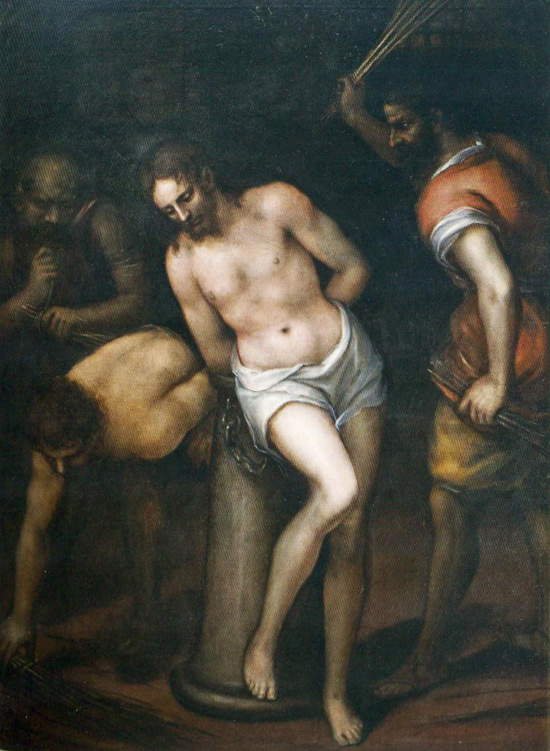 |
| Cesare Corte, Christ at the Column (ca. 1600-1610; oil on canvas, 169 x 120 cm; private collection) |
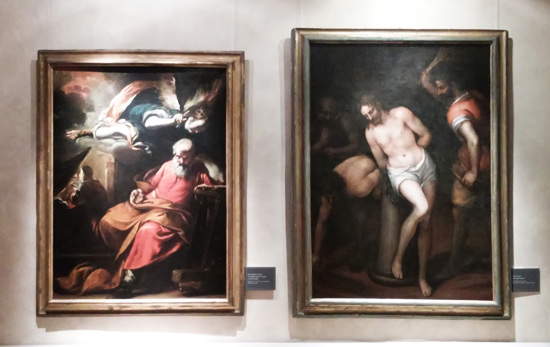 |
| Cesare Corte’s work at the Luciano Borzone exhibition, next to Joachim Assereto’sApparition of the Angel to St. Joseph |
It is possible to discern such cues in a key work by the Genoese artist, the Baptism of Christ from the Palazzo Bianco in Genoa, which is not in the monographic exhibition but is included in the collateral itineraries. It is a work that Luciano Borzone executed by 1621: it was intended for the church of Santo Spirito in Genoa, and more specifically for the chapel of the Pinelli family, one of the most prominent in the city (the same chapel was commissioned by Agostino, who was doge of the Republic between 1609 and 1611). It is a work that also aroused the approval of Orazio Gentileschi: Soprani tells us that among the panels “worthy of much praise” by Luciano is this Baptism, and these works “induced Oratio Gentileschi to seek out who was its author, and visit him in his house to acquire the friendship, which was between them while they lived inseparable.” Let’s take a closer look at the painting: under an evocative sky in which we see the clouds open, like a curtain, to let the Holy Spirit enter the scene and flood the composition with divine light, we observe a kneeling Christ receiving water from John the Baptist, who, as tradition dictates, is dressed in his tunic of camel hair. The layout of the painting is clearly of Veronese influence: it is possible that Venetian suggestions came to Borzone precisely thanks to Cesare Corte, but probably also thanks to his direct study of a painting attributable to Tintoretto’s workshop preserved in the church of Nostra Signora degli Angeli in Voltri (a painting restored last year, the results of which were the subject of a publication entitled Restorations in the church of Nostra Signora degli Angeli). But the master’s example can also be seen in the chiaroscuro passages, as delicate as those of Cesare Corte: Borzone uses them to emphasize even more his much more naturalistic art.
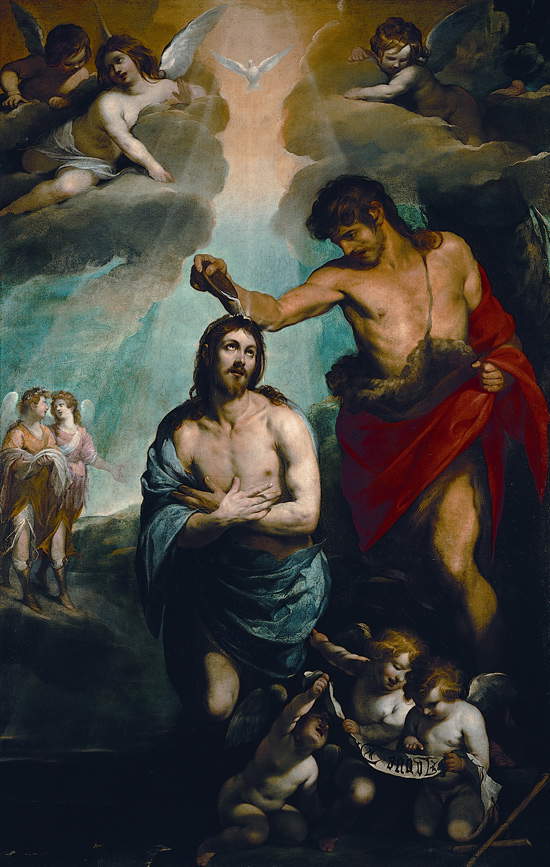 |
| Luciano Borzone, Baptism of Christ (c. 1620-1621; oil on canvas, 252.5 x 163 cm; Genoa, Museo di Palazzo Bianco) |
The use of light to model bodies was the prerogative of another painter who was a decisive point of reference for Luciano Borzone: Giovanni Battista Paggi (1554 - 1627), a painter of noble origins, who is present at the monographic exhibition on Luciano Borzone with an interesting painting having Venus and Cupid in the Vulcan Forge as its subject. The painting, from 1624, is illustrative in showing Paggi’s ability to use light to shape the figures, which in this case emerge from a dark background, revealing themselves to the viewer with refined poses that aim to create a particularly animated composition. If we notice, the heads of all the figures in the scene are arranged along a spiral that ends at the lower edge of the scene, with Cupid’s foot: this dynamism often connotes Paggesque compositions, and it also returns in Borzone’s works close to the example of the older painter who, we know again from Soprani, became Borzone’s friend. The direct comparison, in this case, is with a very particular Susanna e i vecchioni datable to the late 1930s: a Junoesque Susanna (who, as Anna Manzitti points out in the exhibition catalog, in her generous forms closely resembles the women of Pieter Paul Rubens: as is well known, the great Dutch painter sojourned in Genoa) is undermined, as per the biblical tale, by the two old men, and to escape she performs an abrupt movement with her arms. The left tries to cover her body, as far as possible, with a white cloth, while the right, brought forcefully forward, tries to evade one of the old men: we will find this approach again in another Susanna and the Old Men, a theme that therefore recurs in Borzonesque painting. The movement, which is reminiscent of Giovanni Battista Paggi’s solutions (the arm looks almost the same as in the Venus discussed above), accentuates the tension of the moment, which is already quite high (though not exaggerated or without excess) thanks to the effective rendering of the characters’ expressions. Moreover, Borzone tries, like Paggi, to shape his figures through the skillful use of light, a light that knows how to be both gentle and strong enough to bring out the volumes of the protagonists.
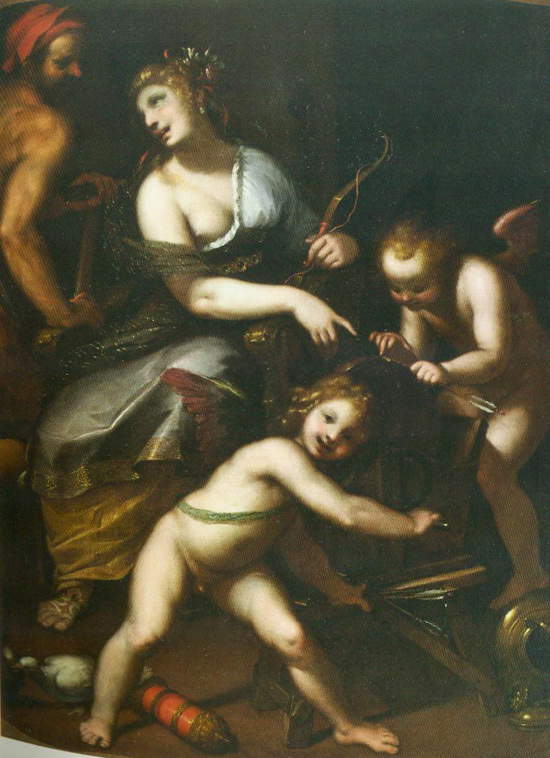 |
| Giovanni Battista Paggi, Venus and Love in the Forge of Vulcan (ca. 1624; oil on canvas, 165 x 127 cm; private collection) |
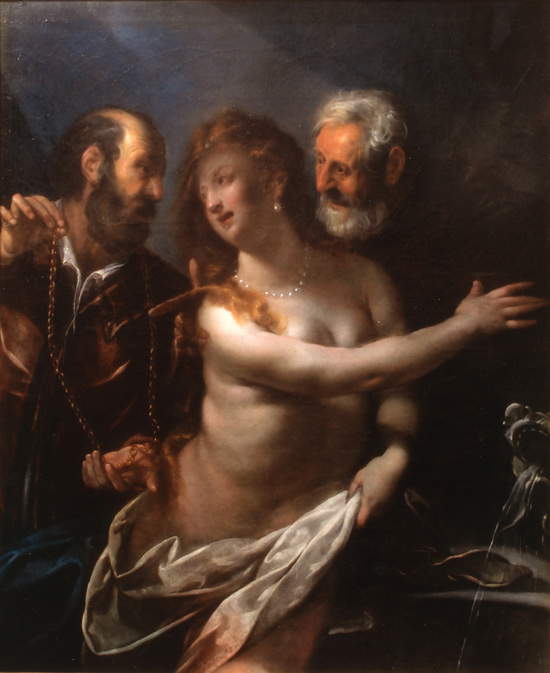 |
| Luciano Borzone, Susanna and the Old Men (c. 1635-1639; oil on canvas, 136 x 110 cm; private collection) |
It is difficult to give a brief account of all these suggestions, summarized here, by necessity, in a rather cramped space: one of the best ways to realize how vital Genoa was in the early seventeenth century (and, therefore, how much fascination this environment, so culturally and artistically lively, exerted on the young Luciano Borzone) is to travel to the Ligurian capital and, of course, to visit the significant exhibition on Luciano Borzone, which we can undoubtedly count among the most interesting events of 2016.
Warning: the translation into English of the original Italian article was created using automatic tools. We undertake to review all articles, but we do not guarantee the total absence of inaccuracies in the translation due to the program. You can find the original by clicking on the ITA button. If you find any mistake,please contact us.